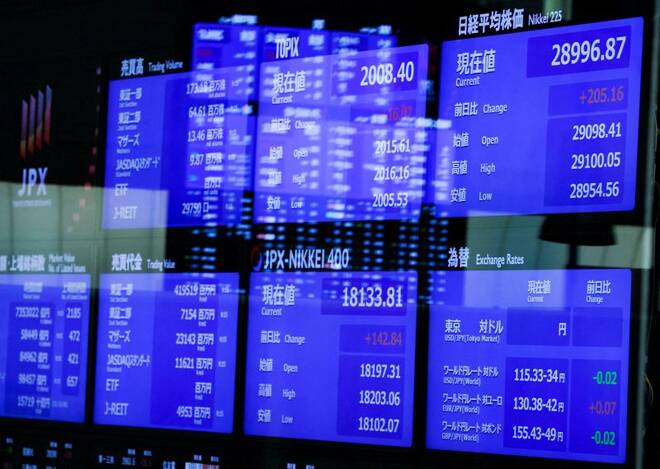Advertisement
Advertisement
Wall St gets respite from positive data, dollar pullback
By:
By Wayne Cole SYDNEY (Reuters) - Asian shares slipped on Monday as markets were forced to price in ever-loftier peaks for U.S. and European interest rates, slugging bonds globally and pushing the dollar to multi-week highs.
By Lawrence Delevingne and Amanda Cooper
(Reuters) – Wall Street and global shares rebounded modestly on Monday on favorable economic data and bargain hunting, but remained within sight of recent six-week lows, as investors prepared for higher interest rates in the United States and Europe.
U.S. core capital goods orders accelerated in January, beating forecasts, according to government figures released on Monday, and contracts to buy previously owned U.S. homes rose the most in more than 2-1/2 years in January.
At the same time, Federal Reserve Governor Philip Jefferson said on Monday he was under “no illusion” that inflation would return quickly to the Fed’s target, with the cost of a broad array of services in the United States still “stubbornly high.”
Amid a confounding mix of economic signals, Wall Street shares edged up on Monday, a sign of potential bargain hunting. The Dow Jones Industrial Average rose 0.2% to 32,889.09, the S&P 500 gained 0.3%, at 3,982.24, and the Nasdaq Composite added 0.6%, at 11,466.98.
The MSCI All-World index of global shares was up 0.44% after dropping 2.6% last week, its largest weekly decline since late September thanks to a sizzling rally in the dollar.
The index is heading for a nearly 3% decline in February, after a rally the month before drove many major stock indices to their strongest January performance in years.
“With the equity market showing signs of exhaustion after the last Fed meeting, the S&P 500 is at critical technical support,” Morgan Stanley U.S. equity analysts wrote in a note on Monday. “Given our view on earnings, March is a high risk month for the bear market to resume.”
January’s euphoria, founded on expectations that major economies will avoid tumbling into recession this year, has given way to something approaching realism about the outlook for interest rates, which are going to rise more and stay high longer than many had previously anticipated.
“Fed speak this week … will emphasize the need for more rate hikes, as per usual by now,” TD Securities strategists wrote in a note on Monday. If economic data for February is as strong in January, “some officials might signal upside risk to their rate outlook,” they added.
Fed futures now have rates peaking at around 5.4%, implying at least three more hikes from the current 4.50% to 4.75% band, and some chance of 50 basis points in March.
When the Fed concluded its last policy meeting in early February, prior to the release of bumper January employment, consumer spending, and business-sector activity data, markets showed traders expected a peak rate of 4.73%, meaning that almost an extra three-quarters of a point is now priced in.
U.S. two-year Treasury yields, the most sensitive to shifts in interest-rate expectations, have risen almost 80 bps in that time, while the S&P 500 has lost 6% from Feb. 2’s five-month highs.
On Monday, the two-year U.S. Treasury yield fell 2 basis points to 4.785%, while 10-year Treasury yields dropped 2.3 basis points to 3.926%.
Stocks recoup some losses
European stocks bounced back on Monday, as typically rate-sensitive sectors such as oil and gas and technology picked up after falling sharply last week by 1.4% and 3.8% respectively.
The STOXX 600, which last week lost 1.4%, was up about 1.1%.
Economists at British banks Barclays and Natwest both said they believe the Fed could raise rates by as much as half a percentage point in March, well above the quarter-point that markets have priced in.
It is not just the United States where investors believe the central bank will have to keep raising rates to reduce inflation. Money markets show traders believe the European Central Bank and the Bank of England will have to lift rates to a higher peak and leave them there for longer.
Bruce Kasman, head of economic research at JPMorgan, has added another quarter-point hike to the ECB outlook, taking it to 100 basis points. Germany’s 2-year bond yield broke above 3.0% on Friday for the first time since 2008.
“The risk is clearly skewed toward greater action from the Fed,” Kasman said.
The dollar has been the main beneficiary of the shift in expectations for Fed rates.
It has risen by around 2.5% this month against a basket of major currencies , which would mark its strongest monthly performance since September, when it hit 20-year highs.
It was last down 0.5% on the day, pushed in part by gains in the pound, which gained about 1% as British Prime Minister Rishi Sunak struck a deal with the European Union on post-Brexit trade rules for Northern Ireland.
Oil prices declined on Monday as the dollar’s recent strength discouraged buying, though losses were limited by supply concerns after Russia halted exports to Poland via a key pipeline. U.S. crude fell 0.85% to $75.67 per barrel and Brent was at $82.25, down 1.09% on the day.
Spot gold added 0.4% to $1,817.40 an ounce.
(Reporting by Lawrence Delevingne in Boston and Amanda Cooper in London. Additional reporting by Wayne Cole in Sydney; Editing by Susan Fenton, Christina Fincher, Angus MacSwan and Richard Chang)
About the Author
Reuterscontributor
Reuters, the news and media division of Thomson Reuters, is the world’s largest international multimedia news provider reaching more than one billion people every day. Reuters provides trusted business, financial, national, and international news to professionals via Thomson Reuters desktops, the world's media organizations, and directly to consumers at Reuters.com and via Reuters TV. Learn more about Thomson Reuters products:
Did you find this article useful?
Latest news and analysis
Advertisement
